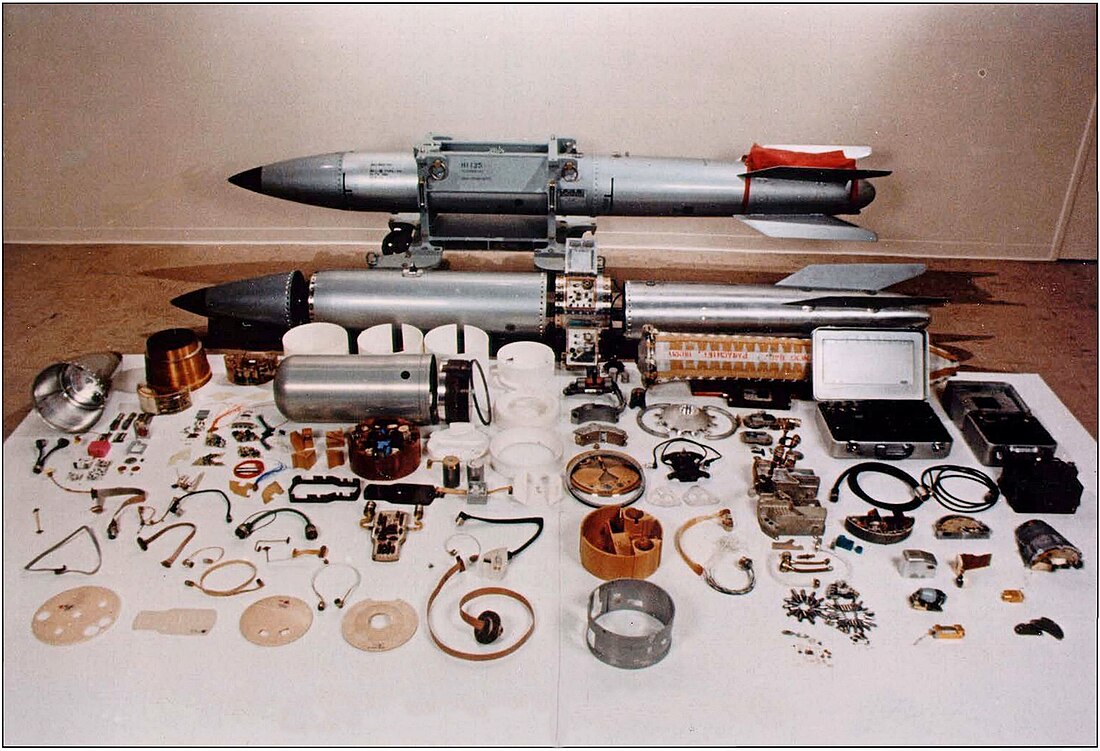Top Qs
Timeline
Chat
Perspective
Warhead
Section of a device that contains the explosive agent or toxic material From Wikipedia, the free encyclopedia
Remove ads
A warhead is the section of a device that contains the explosive agent or toxic (biological, chemical, or nuclear) material that is delivered by a missile, rocket, torpedo, or bomb.
This article includes a list of references, related reading, or external links, but its sources remain unclear because it lacks inline citations. (February 2014) |

Remove ads
Classification
Summarize
Perspective
Types of warheads include:
- Explosive: An explosive charge is used to destroy the target and damage surrounding areas with a blast wave.
- Conventional: Chemicals such as gunpowder and high explosives store significant energy within their molecular bonds. This energy can be released quickly by a trigger, such as an electric spark. Thermobaric weapons enhance the blast effect by utilizing the surrounding atmosphere in their explosive reactions.
- Blast: A strong shock wave is provided by the detonation of the explosive.
- Fragmentation: Metal fragments are projected at high velocity to cause damage or injury.
- Continuous rod: Metal bars welded on their ends form a compact cylinder of interconnected rods, which is violently expanded into a contiguous zig-zag-shaped ring by an explosive detonation. The rapidly expanding ring produces a planar cutting effect that is devastating against military aircraft, which may be designed to be resistant to shrapnel.
- Shaped charge: The effect of the explosive charge is focused onto a specially shaped metal liner to project a hypervelocity jet of metal, to perforate heavy armour.
- Explosively formed penetrator: Instead of turning a thin metal liner into a focused jet, the detonation wave is directed against a concave metal plate at the front of the warhead, propelling it at high velocity while simultaneously deforming it into a projectile.
- Nuclear: A runaway nuclear fission (fission bomb) or nuclear fusion (Thermonuclear weapon) reaction causes immense energy release.
- Conventional: Chemicals such as gunpowder and high explosives store significant energy within their molecular bonds. This energy can be released quickly by a trigger, such as an electric spark. Thermobaric weapons enhance the blast effect by utilizing the surrounding atmosphere in their explosive reactions.
- Chemical: A toxic chemical, such as poison gas or nerve gas, is dispersed, which is designed to injure or kill human beings.
- Biological: An infectious agent, such as anthrax spores, is dispersed, which is designed to sicken or kill humans.
Often, a biological or chemical warhead will use an explosive charge for rapid dispersal and enhanced damage.
Remove ads
Detonators
Explosive warheads contain detonators to trigger the explosion.
Types of detonators include:
Remove ads
See also
References
Wikimedia Commons has media related to Warheads.
- "The B61 (Mk-61) Bomb". The Nuclear Weapon Archive. 9 January 2007. Archived from the original on Nov 30, 2023.
- "B61". GlobalSecurity.org. April 16, 2017. Archived from the original on Mar 16, 2023.
- "B61 Nuclear Gravity Bomb". Brookings Institution. Archived from the original on Mar 10, 2012.
- Stephen I. Schwartz. "Atomic Audit - The Costs and Consequences of U.S. Nuclear Weapons Since 1940". Brookings Institution Press, 1998.
- "B61 Thermonuclear Bomb". Hill Air Force Base. 2008. Archived from the original on May 25, 2011.
- "NNSA Achieves Significant Milestone for B61 Bomb". NNSA. June 30, 2006. Archived from the original on Jul 30, 2009.
- Chuck Hansen, U.S. Nuclear Weapons: The Secret History, (New York: Orion Books, 1988), pp. 162–164.
Remove ads
Wikiwand - on
Seamless Wikipedia browsing. On steroids.
Remove ads
